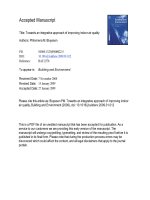HACCP - An Applied Approach
Bạn đang xem bản rút gọn của tài liệu. Xem và tải ngay bản đầy đủ của tài liệu tại đây (3.85 MB, 17 trang )
7
HACCP:
An Applied Approach
Todd Konietzko
CONTENTS
HACCP to Control Hazards
What Are the BeneÞts of a HACCP System?
Hazard Components
Supporting Programs (Prerequisites/Good Manufacturing Practices)
DeÞnitions
Development of a HACCP Plan
Assemble the HACCP Team
Describe the Food and Its Distribution
Describe the Intended Use and Consumers of the Food
Develop a Flow Diagram that Describes the Process
Verify the Flow Diagram
The Principles of HACCP
Principle 1 — Conduct a Hazard Analysis
Examples of Questions to Be Considered When
Conducting a Hazard Analysis
Principle 2 — Determining Critical Control Points (CCPs)
Principle 3 — Establishing Critical Limits
Principle 4 — Establishing Monitoring Procedures
Principle 5 — Establish Corrective Actions
Exceeding the Limit
Principle 6 — Establishing VeriÞcation Procedures
Validating the HACCP Plan
Principle 7 — Records
Juice product safety has become more important with recent foodborne
outbreaks that have been linked to juice products. A lack of programs related
to food safety may result in personal injury to consumers and economic loss
to the manufacturer. However, manufacturing is often the last opportunity to
TX110_book Page 157 Tuesday, May 6, 2003 9:21 AM
© 2003 by CRC Press LLC
ensure safety prior to use by the consumer. The responsibility for ensuring
the safety of juice products rests with the end manufacturer of the product.
Biological hazards are the primary food safety concern; physical and
chemical hazards are also a risk. Injury to the consumer can exist in many
forms such as physical injury (e.g., cut lip or tongue), allergic reactions
(e.g., to a chemical contaminant), illness (food poisoning), and possibly
even death.
The U.S. Food and Drug Administration’s (FDA) Þnal rule on the use
of the Hazard Analysis and Critical Control Point (HACCP) system for
ensuring the safety of juice comes after a number of foodborne illness
outbreaks that have been associated with juice products during the last several
years. Outbreaks have been associated with apple juice and the organism
E.
coli
O157:H7, and citrus juice and
Salmonella
spp. An outbreak associated
with apple juice resulted in over 70 illnesses and one death, and outbreak(s)
linked to citrus products have resulted in over 500 reported illnesses, as well
as one reported death. Foodborne infections are dangerous for the elderly,
the young, and those whose immune systems have been weakened. The FDA
has estimated that over 16,000 cases of juice-related illness occur every year.
The FDA believes that action taken due to the Þnal juice HACCP rule will
prevent an estimated 6000 of those illnesses per year.
HACCP TO CONTROL HAZARDS
Juice products, because of their added sugar, nutrients, and an increase in
the pH of the products, may provide an ideal medium for the growth of
bacteria, including pathogenic bacteria.
A key juice HACCP requirement is the 5-log reduction requirement for
the microbe of concern, which has been identiÞed as the pathogen that has
had a history of outbreaks in a speciÞc juice. This requirement can be satisÞed
by one or a series of measures or steps that can reduce pathogenic bacterial
counts by at least 5 logs. The FDA has recognized pasteurization as a method
for meeting the 5-log reduction requirement. Also, part of the rule states that
the reduction must occur in one processing facility. Measures taken prior to
the receipt of the juice cannot be included in the total 5-log reduction. In
addition, the Þnal processor must have assurance that its HACCP plan results
in the elimination of the pathogen of concern.
WHAT ARE THE BENEFITS OF A HACCP SYSTEM?
The primary concern of a HACCP system and its supporting programs is
food safety. The manufacturer who can successfully implement the food
safety program may also see other beneÞts, including the following:
TX110_book Page 158 Tuesday, May 6, 2003 9:21 AM
© 2003 by CRC Press LLC
1. Decrease in consumer complaints, including physical, illness, and
quality complaints
2. Reduction of holds of product in the manufacturing facility
3. Consumer conÞdence in the brand, leading to retention or increase
in market share
A successful HACCP plan must consider any potential (physical, bio-
logical, chemical) hazard that is reasonably likely to occur. Potential hazards
associated with incoming fruit, foreign material, and added ingredients to
make the Þnished product must all be included in a complete hazard analysis.
During the steps of the process, a control measure should be identiÞed for
each potential hazard.
HAZARD COMPONENTS
Hazards that need to be considered in each facility’s hazard analysis are
those that are reasonably likely to occur in the facility. Consideration should
be given to ingredients, each process step within the facility, and Þnished
product packaging and Þnal storage. The facility’s hazard analysis will be
unique to the particular processing plant. One thing to remember when
performing the hazard analysis is that hazards are deÞned within HACCP
as they relate to product safety. The hazards included in the analysis should
be only those that are reasonably likely to occur in the process being eval-
uated. The FDA Þnal regulation on juice HACCP has identiÞed nine hazards
that must be addressed in the written plant hazard analysis. They are:
1. Microbial contamination
2. Parasites
3. Chemical contamination
4. Decomposition
5. Unlawful pesticide residues
6. Natural toxins
7. Unapproved food or color additives
8. Physical hazards
9. Undeclared ingredients, such as allergens
SUPPORTING PROGRAMS (PREREQUISITES/GOOD
MANUFACTURING PRACTICES)
The manufacturing plant’s HACCP program cannot and is not meant to be
a stand-alone program. Instead, it is part of a larger system including com-
pany Good Manufacturing Practices (GMPs), plant Standard Operating Pro-
TX110_book Page 159 Tuesday, May 6, 2003 9:21 AM
© 2003 by CRC Press LLC
cedures (SOPs), and Sanitary Standard Operating Procedures (SSOPs). Pre-
requisite programs are procedures used to control the plant operating
conditions and employee practices, and ultimately contribute to the produc-
tion of a safe, quality food product.
The effectiveness and existence of prerequisite programs should be
assessed during the design and implementation of the HACCP plan. Prereq-
uisite programs, like the HACCP program itself, should be documented and
audited regularly. Prerequisite programs should be managed separately from
the HACCP program. However, it may be necessary to include parts of a
prerequisite program in the HACCP plan. One possible example would be
a preventative maintenance procedure for equipment to avoid unexpected
down time. During the development of a HACCP plan, it may be decided
that routine maintenance and calibration of a thermometer on a pasteurization
system should be included in the plan as an activity of veriÞcation. This then
would ensure that the product passing through the system met the designated
temperature necessary for the production of a safe food.
In the Þnal juice HACCP regulation, FDA has required that the operating
plant have in place eight SSOPs. These eight SSOPs can be classiÞed as
prerequisite programs. The eight mandatory SSOPs are:
1. Safety of water that comes into contact with food or food contact
surfaces or that is used in the manufacture of ice
2. Condition and cleanliness of food contact surfaces, including uten-
sils, gloves, and outer garments
3. Prevention of cross contamination from unsanitary objects to food,
food packaging materials, and other food contact surfaces, includ-
ing utensils, gloves, and outer garments, and from raw product to
processed product
4. Maintenance of handwashing, hand sanitizing, and toilet facilities
5. Protection of food, food contact packaging material, and food con-
tact surfaces from adulteration with lubricants, fuel, pesticides,
cleaning compounds, sanitizing agents, condensate, and other phys-
ical, chemical, or biological contaminates
6. Proper labeling, storage, and use of toxic compounds
7. Control of employee health conditions that could result in the
microbiological contamination of food, food packaging material,
and food contact surfaces
8. Exclusion of pests from the food plant
The FDA Þnal regulation does not state that these eight SSOPs have to
be written programs; it just requires documentation that the eight SSOPs are
being controlled.
TX110_book Page 160 Tuesday, May 6, 2003 9:21 AM
© 2003 by CRC Press LLC
End product sampling and testing by the processor are not required. If
testing is included as part of the veriÞcation step in the HACCP plan, then
referenced industry-testing records will have to be made available to a
regulatory agency during an audit/inspection of the facility.
DEFINITIONS
In order to develop a HACCP plan, certain terms must be deÞned and
understood:
CCP Decision Tree
A series of questions to determine whether a con-
trol point is a critical control point (CCP).
Control
To manage the conditions of an operation to maintain compli-
ance with established criteria.
Control Measure
An action or activity that can be used to prevent,
eliminate, or reduce a food safety hazard to an acceptable level.
Corrective Action
A written set of procedures that are followed when
a deviation occurs.
Critical Control Point (CCP)
A step at which control can be applied
and is essential to prevent, eliminate, or reduce a food safety hazard
to acceptable levels.
Critical Limit
A maximum and/or limited value to which a biological,
chemical, or physical parameter must be controlled at a CCP to
prevent, eliminate, or reduce to an acceptable level the occurrence
of a food safety hazard.
Deviation
Failure to meet a critical limit.
HACCP plan
The written document based on the principles of HACCP
that explains procedures to be followed to ensure control is based
on the seven principles of HACCP.
HACCP team
The group of people in the processing facility who are
responsible for the development, implementation, and maintenance
of the HACCP system.
Hazard
A biological, chemical, or physical agent that is reasonably
likely to cause illness or injury in the absence of control.
Hazard analysis
The process of collecting and reviewing information
and data on hazards associated with the food under consideration,
to decide which are signiÞcant and must be addressed in the
HACCP plan.
Prerequisite Programs
Procedures and policies, including GMPs,
SOPs, and SSOPs, that address operational conditions, which pro-
vide for the foundation of the HACCP system.
TX110_book Page 161 Tuesday, May 6, 2003 9:21 AM
© 2003 by CRC Press LLC
Validation
The element of veriÞcation, which is focused on collecting
and evaluating scientiÞc and technical information to determine if
the HACCP plan, when properly implemented, will effectively
control the identiÞed hazards.
VeriÞcation
Activities other then normal monitoring that determine the
validity of the HACCP plan and that the system is operating accord-
ing to the plan.
DEVELOPMENT OF A HACCP PLAN
Development of a facility’s HACCP plan is not a task that can be accom-
plished by one individual. First and foremost, it is necessary to get the needed
commitment from all management levels of the facility. Five preliminary
tasks must be accomplished before the plan can be developed. They are:
Assemble the HACCP team.
Describe the food (produced) and its distribution.
Describe the intended use and consumers of the food.
Develop a ßow diagram that describes the ßow in the facility.
Verify the ßow diagram.
A
SSEMBLE
THE
HACCP T
EAM
The members of the HACCP team are individuals who have knowledge and
expertise appropriate to the facility’s products and processes. This team is
then responsible for the development of the HACCP plan. The team should
be cross-functional and include employees from production, sanitation, qual-
ity assurance/control, microbiology, engineering, and management. Occa-
sionally, the HACCP team may need assistance from outside consultants
(experts) who are knowledgeable about possible chemical, physical, and
biological hazards associated with the process or Þnal product.
D
ESCRIBE
THE
F
OOD
AND
I
TS
D
ISTRIBUTION
The Þrst task of the HACCP team is to describe the food. This task consists of
a general description of the food, ingredients, processing, and Þnal packaging.
The distribution method should be described, along with information on whether
the food is to be distributed frozen, refrigerated, or at ambient temperatures.
D
ESCRIBE
THE
I
NTENDED
U
SE
AND
C
ONSUMERS
OF
THE
F
OOD
In this area, the team shall describe the expected use of the food and the
intended users, whether general public or a particular segment of the popu-
lation (e.g., infants, elderly people, etc.).
TX110_book Page 162 Tuesday, May 6, 2003 9:21 AM
© 2003 by CRC Press LLC









